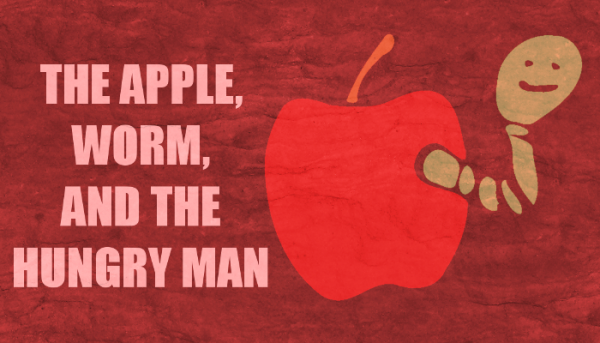
Writers typically think of Point of View (POV) as the person who’s telling the story. Storytellers, however, add a level of sophistication by considering the multiple POVs that exist within it. Since each role (customer, vendor, investor, employee, etc.) reacts differently to events depending on what they know, savvy business storytellers structure their stories around Who Knows What? (StoryHow™ PitchDeck Card #42).
For example, let’s look at the story-structure possibilities surrounding a hungry man about to bite into an apple with a worm in it. A storyteller can influence an audience’s perception by choosing Who Knows What?.
1. The audience knows more than the man:
If the audience knows about the worm but the man doesn’t, the storyteller has two options:
a. If members of the audience care about the man, they will empathize with him, experiencing emotions of stress and discomfort as he’s biting into the apple.
b. If the man is unlikeable, comedy may ensue as the audience delights in his comeuppance.
2. The man knows more than the audience.
If a storyteller gives a character more information than the audience, she must also fill that void by leaving clues, such as describing the man’s strange behavior. In this case, the audience will wonder why the man is behaving oddly until the storyteller chooses to reveal one of two things: the hole in the apple or what’s left of the worm.
3. The man and the audience know the same thing.
Another way storytellers steer an audience is to give each the same knowledge. Here are three situational possibilities:
a. They both know that there’s a worm in the apple. Perhaps the man has been challenged to a dare. In this case, the audience and the man share feelings such as anticipation, stress, and disgust.
b. Neither knows that there’s a worm in the apple. If neither the audience nor the character knows that the apple contains a worm, there’s no suspense leading up to the bite, but both will share in the horror of the afterbite.
c. Neither knows about the worm, but another character does. Perhaps a prankster has given the man an apple with a worm in it. While neither the man nor the audience knows about the worm, the storyteller ensures that one or both notice the prankster’s strange behavior. While the prankster’s actions are seen as perplexing pre-bite, both the audience and the man will understand everything post-bite.
We’ve shown six different ways of using Who Knows What? with just three roles: man, audience, and a prankster. A storyteller’s opportunity to change the audience’s perception increases exponentially by adding more POVs–such as the worm’s.
4. Look at the story from the worm’s POV:
a. If the worm doesn’t know about the man, the story is a tragedy.
b. If the worm knows about the man, the storyteller can write a suspense-thriller or a comedy.
It all depends on Who Knows What?
So, how can you use the concept of Who Knows What? to change the way an audience participates with your story?